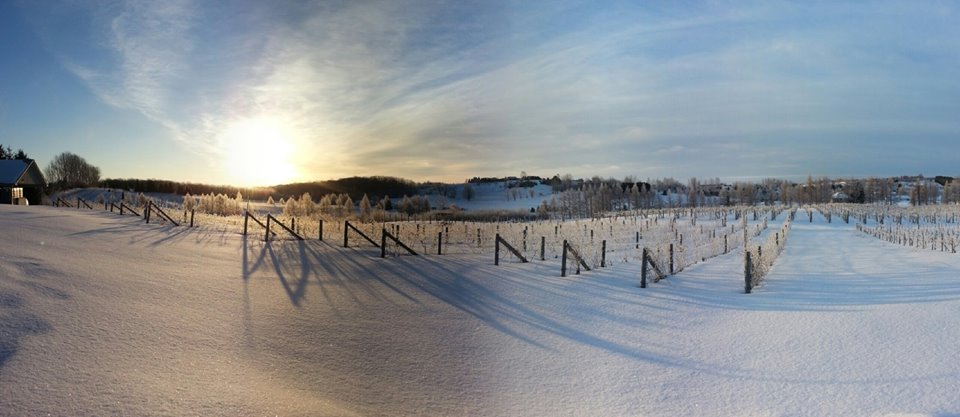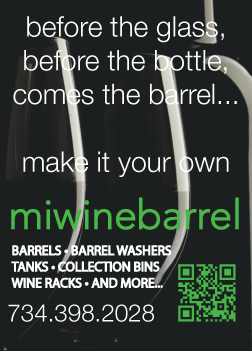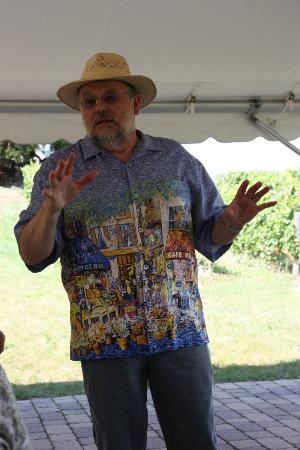Mawby’s Masterpieces of Michigan
This article is sponsored by MI Wine Barrel, makers of durable and economic stainless steel wine barrels.
Larry Mawby isn’t only one of Michigan’s wine pioneers, he’s also one of the funniest people you’ll ever meet. Like his methode champenoise sparkling wines, you’ll need to pay close attention to garner the full benefit of both his humor and his complex L. Mawby wines.
M. Lawrence wines, on the other hand, are fun and made using the Charmat method, a simpler, faster and less costly method of making sparkling wines than the traditional Champagne method.
Way back in 1973 when he planted his first vines on the Leelanau Peninsula, there weren’t many other wineries as neighbors (Michigan now has 100+ wineries). Growing up in a farming family, Larry returned to his agricultural roots after earning a degree in English at Michigan State University. That degree is reflected in his whimsical way with words on his labels.
He was instrumental in creating the Leelanau Peninsula AVA designation, Michigan’s second AVA. As he says, “I really didn’t know what grapes would grow well and, more importantly, what consumers would want to buy. I planted lots of hybrids. Vignoles, Vidal Blanc and Traminette were planted as well as Pinot Noir and Chardonnay. That’s what we thought would grow best on this peninsula.”
The tasting room opened in 1978 and then as now, was a very casual, friendly spot to enjoy a glass or six of wine. Marketing is very “tongue-in-cheek”. Asking guests if they want to “become a Bubblehead” or “be one with the Froth” is not only clever, it’s also effective marketing.
While Michigan had a history of (mostly sweet) sparkling wine production, in 1984 Larry set his sights on mastering the method used in France. He believed that, due to the similarity of terroir and location on the 45th parallel, his property was ideally suited to grow the same grapes used to make Champagne. While only wine made in Champagne, France can be legally labeled Champagne, L. Mawby wines are produced using the same labor intensive methode champenoise (Champagne method) that produces Champagne. Since 2000 he’s focused solely on crafting sparkling wines.
As mentioned earlier, there are two basic ways to produce sparkling wine. The first method known as methode champenoise (Champagne method) is the only way to make Champagne. This procedure requires the wine to undergo a secondary fermentation in the bottle. Naturally, it’s more time-consuming and therefore more expensive than other methods.
This is the traditional method used to craft L. Mawby wines. They are aged in the bottle before disgorging, with many cuvees (blends) given 3 or more years of aging in the bottle. Eleven different sparkling wines are available from L. Mawby. The Blanc de Blanc is primarily Chardonnay. Elegant and refined, it’s the signature L. Mawby wine.
M. Lawrence wines are made using the Charmat or cuvee close method of production. Instead of undergoing a second fermentation in the bottle, the juice is fermented in stainless steel tanks with the second fermentation in closed stainless steel tanks.
Requiring less aging than the traditional method, M. Lawrence brand wines are less expensive and more widely available then the L. Mawby wines. Fruity and fun, eight different selections fall under the M. Lawrence moniker. Perhaps the most popular is named Sex. Go figure, a wine named Sex, use your imagination to come up with the tagline for this wine! Other wines are named Wet, Fizz and Detroit. A recent addition is Redd. This unusual bubbly is crafted from handpicked Regent and Marechal Foch grapes creating a red sparkling wine!
The bubblies are fizzing along but the challenging climate was also something I discussed with Larry at the recent Michigan Wine Showcase. He expressed the opinion – backed by the vast majority of scientists – that climate change is real.
As evidenced by this past winter, the cold temperatures are getting colder and the warm temperatures are getting warmer. “This winter, just about everyone I know suffered some damage,” Larry said. He also mentioned that, “vineyards in Southwestern Michigan appear to have sustained greater loss than growers on the Leelanau Peninsula and Old Mission Peninsula.”
Hybrids grape buds aren’t as affected by the cold winter as vinifera. But according to Mawby, wine drinkers have the biggest influence on the types of grapes that get planted. “While growers have always liked hybrids for their hardiness and durability, the question is: what do consumers want?” Larry concluded.
Michael Schafer Esq., The Wine Counselor®, is a wine educator, speaker, Sommelier, C.S.W., writer and consultant who entertains while educating. His approach to wine is reflected in his trademark phrase, ‘I taste bad wine so you don’t have to”®
For more information see: www.winecounselor.net




